Namba
last update: June 20, 2022
The city of Osaka is generally portrayed as a city of two centers, one to the north (
Umeda), the other just
Namba (難波), to the south. Due to its geographical location, the area is also called
Minami (ミナミ), which means "south" in Japanese. Namba, or Minami if you prefer, has an edge over Umeda. It is the most famous entertainment district in the city and offers an endless choice of restaurants and shops, as well as nightclubs and other attractions open 24 hours on 24 which make this district one of the "never sleeps" ones. Any tourist who comes to Osaka usually takes a walk in
Dotonbori in Namba among the first things.
Things to do and things to see in Namba
Namba is a neighborhood with an explosive vitality, where you can have fun in a thousand different ways: shopping, restaurants, bars, karaoke, arcades, and much more. Just wandering around its streets is in itself a must-see for anyone visiting Osaka for the first time. The area is very large and can be divided into several small neighborhoods, each with certain characteristics and which deserve to be fully explored: from the chaos of
Dotonbori, full of restaurants and nightclubs, to the department stores and high fashion stores of
Shinsaibashi, and to
Amerikamura, the district of extravagant young people and alternative fashion boutiques. In the area there are several covered shopping streets, and where you can spend a few hours even in case of rain. There is no shortage of mega commercial complexes, among which it is worth mentioning the modern
Namba Parks, with its roof gardens and its artificial canyon. Finally, for art and history buffs, you can attend a performance of an ancient Japanese theatrical art known as bunraku, or visit a ukiyo-e museum.
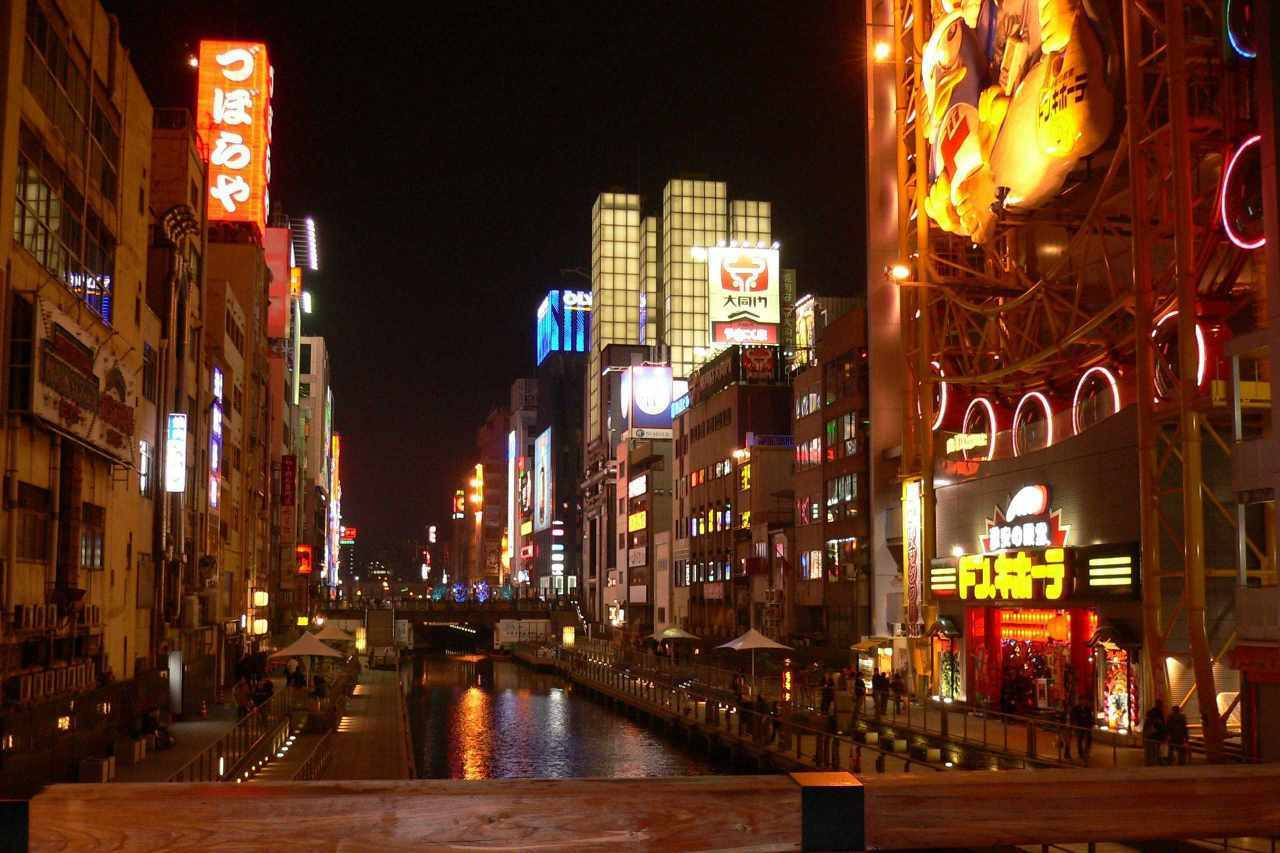
Dotonbori
Dotonbori is the heart of Namba and with this name we refer precisely to the street parallel to the canal that bears the same name, although often by Dotonbori people mean the whole area around the canal. The area is always very crowded, during the day and especially at night, when the crowd combined with the neon lights that shine everywhere make it incredible. Dotonbori is an area full of restaurants and highly recommended in tourist guides to stop and eat the typical dishes of Osaka, as well as to enjoy the delirium of people, lights and colors typical of this lively city. Strange as it may seem, the neighborhood's landmarks, as well as the most photographed places, are the Kani Doraku crab, a giant mechanical (moving) sign in the shape of a crab of a restaurant specializing (guess what) in crabs, and the neon sign called Glico Man, advertising a brand of candies, but there are many other curious signs in the area.

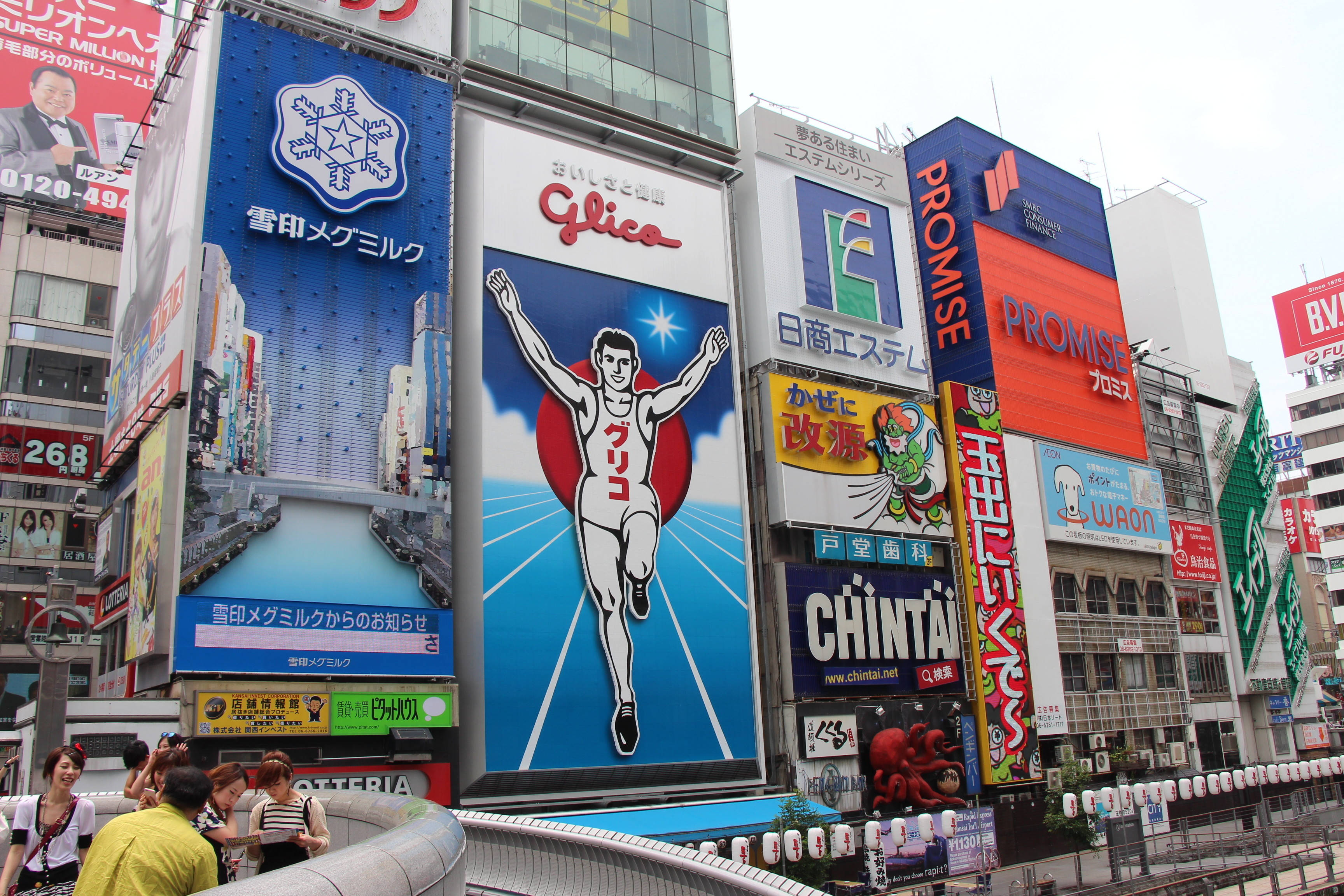 The Kani Doraku (mechanical crab) and the Glico Man sign, two landmarks of Dotonbori
The Kani Doraku (mechanical crab) and the Glico Man sign, two landmarks of Dotonbori
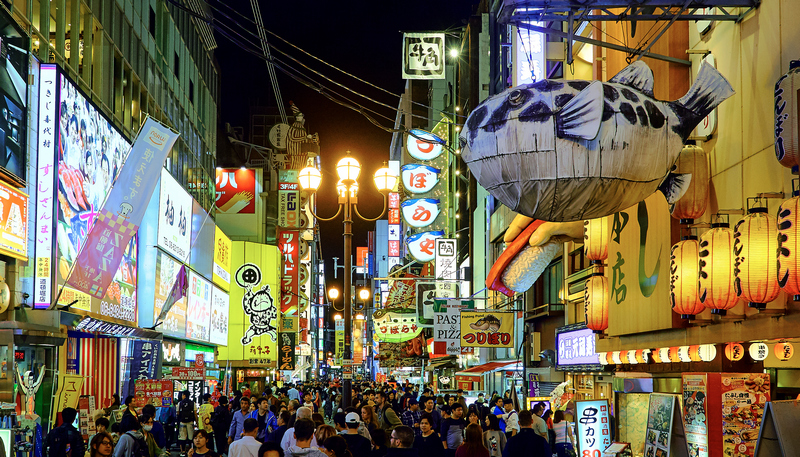 Dotonbori
Dotonbori
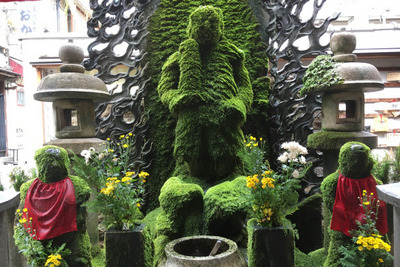
Hozenji Temple
The Hozenji Temple, the only historical monument in the area, is a Buddhist temple from the 1600s that can be visited for free. Within the temple grounds there is a moss-covered Buddha statue, called Mizukake Fudo, which visitors bathe with water, in the belief that this brings good luck. The narrow street in front of the temple and the parallel one next to it, known as Hozenji Yokocho, are very characteristic and represent one of the rare glimpses with an "old Osaka" atmosphere of Namba, with its stone floors and many small izakaya.
Shinsaibashi
Shinsaibashi is considered to be the main commercial area of the whole city of Osaka. It develops along two main streets. To the east there is a shopping arcade called Shinsaibashi Suji: about 600m long, this always busy street combines retail chains, sophisticated boutiques and expensive department stores dedicated to the big names in fashion. Along this street there is also one of the rare museums in all of Namba, the Osaka Ukiyoe Museum. To the west there is Mido-suji Dori, a large and elegant tree-lined avenue where there are numerous department stores (Parco, Loft, Tokyu Hands) and large single-brand stores of famous international brands. Often associated with Shinsaibashi is also the Amerikamura area, another very popular shopping area especially among teenagers.
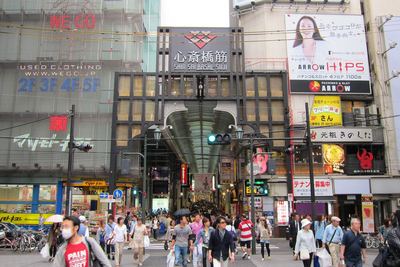
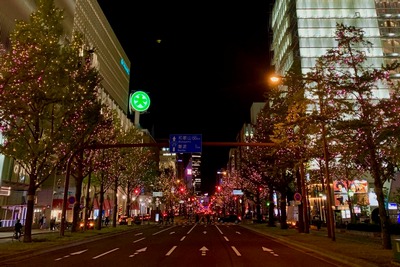 Shinsaibashi-suji and Mido-suji Dori
Shinsaibashi-suji and Mido-suji Dori
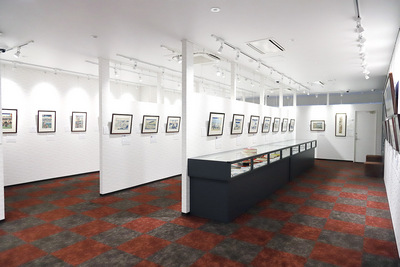
Osaka Ukiyoe Museum
(admission 1000¥, opening hours 10-17, closed on mondays)
A small museum opened in 2019 along the Shinsaibashi-suji shopping arcade. The museum displays a collection of ukiyo-e prints, one of the art forms for which Japan is known around the world. Among the various works, there are several by famous artists such as Katsushika Hokusai, Utagawa Hiroshige, Kitagawa Utamaro and Toshusai Sharaku.

Amerikamura
Amerikamura is a "neighborhood within the neighborhood" of Namba, just north of the Dotonbori canal. Also called "Ame-mura", it was once famous as a commercial area for Western (especially American) products, today it has partly lost this characteristic becoming the heart of youth fashion in Osaka, a sort of equivalent of Harajuku in Tokyo. Here you will find numerous youth fashion shops, also used, music shops, cafes, bars and nightclubs, some run by foreigners. On weekends the streets are filled with stalls and a few street performers. The meeting point par excellence in the area is Sankaku Koe, also called Triangle Park due to its triangular shape, a small green square where you can sit on the benches and enjoy the spectacle of the extravagantly dressed people. A few meters from Triangle Park you will find two curious icons of the neighborhood. One, a reproduction of the statue of liberty on the roof of a building, and two, the large "Peace On Earth" mural painted by artist Seitaro Kuroda in 1983.

Namba Parks
Namba Parks is a modern building complex dating back to 2003 and designed by the American architect Jon Jerde. The idea was to artificially create a natural environment that breaks with the urban environment. The peculiarity of the structure lies in its roof, which houses a hanging garden in the different terraces that follow one another at different heights. The garden is full of trees, flowers, lawns, streams, waterfalls, ponds and beautiful outdoor terraces. Here you can find a green oasis in the beating heart of Osaka but also enjoy a beautiful view over the city. The complex is also cut in two by a sort of artificial canyon. Inside Namba Parks there is a shopping mall up to the 5th floor, while from the 6th floor onwards there is a wide choice of restaurants. On the top floor (8F) there is also an outdoor amphitheater and a cinema. Also part of the complex is the adjacent office skyscraper (149 m), the Parks Tower, which was previously renamed PS3 Tower due to its resemblance to the Sony Playstation 3 console.
 Nipponbashi, sometimes also called Den Den Town, is a commercial area south-east of Namba station dedicated to lovers of anime, manga and videogames, as well as electronics and computers. The little Akihabara of Osaka.
Nipponbashi, sometimes also called Den Den Town, is a commercial area south-east of Namba station dedicated to lovers of anime, manga and videogames, as well as electronics and computers. The little Akihabara of Osaka.
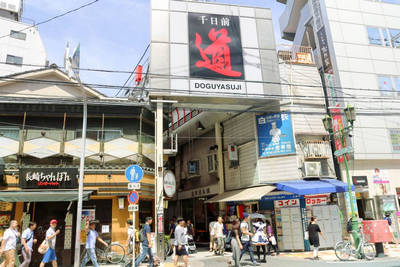
Doguya Suji
Doguya-suji is a covered arcade of catering stores, something like Kappabashi-dori in Tokyo's Asakusa neighborhood. It is located a few meters east of Namba station and the entrance is easily recognized because at the beginning there is the inscription "Doguya-suji" also in the Latin alphabet. The range of kitchen utensils and appliances available along Doguya Suji is astounding (remember Osaka is nicknamed the kitchen of Japan). Recommended for buying precious souvenirs such as Japanese chef's knives, bowls, chopsticks and the typical wax food samples, but even if you do not intend to buy anything it is interesting to take a look at the items on sale.
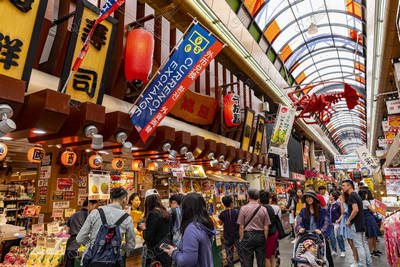
Kuromon Ichiba Market
Kuromon Ichiba Market is another covered shopping street around 600 meters long. It is located north-east of Namba station (800 meters on foot) and and very close to Nipponbashi metro station, on the south side. This street is also easily identifiable as at the beginning you can see the word "Kuromon Market" in the Latin alphabet. Along this street there are about 150 commercial establishments, mainly specialized in fresh fish and seafood, but also fresh fruit and vegetables, meat, dried fish, pickles, sweets and cheap clothing. There are also some restaurants, which are also very cheap, but many stalls cook and serve their food directly on the spot, in a very authentic atmosphere loved by tourists.
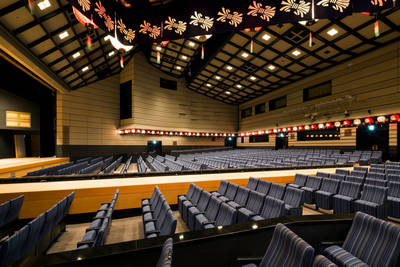
National Bunraku Theater
The National Bunraku Theater in Osaka, located near Nipponbashi Station, is one of the few places today where you can still see the fascinating bunraku, a Japanese theatrical art that includes shows with large puppets manipulated on sight. This unique theatrical form developed right in Osaka in the 17th century as popular entertainment for ordinary people. At this theater you can relive the shows that have enchanted the people of the city for centuries. The price of a ticket varies from 2000 to 5000 yen and earphones in English are often available to follow the performances. The shows are not held all year round, but usually only in the months of January, April, June, July, August and November. More information at this link, while here here you can buy tickets directly online.
Where to stay in Namba
The Namba area is perfect for lodging during your stay in Osaka. It is well connected with the whole city, the offer of shops and restaurants is endless, and there are hotels for all budgets, even very cheap ones, especially if you think that we are talking about the heart of the second most important city in Japan.
Hostels and capsule hotels
- Khaosan World Namba, a modern hostel, with capsule-like beds providing some privacy, very popular with young people and 500 meters from Dotonbori. Starting from 2400¥ per night.
- Capsule&Spa Grand Sauna Shinsaibashi, an old-fashioned capsule hotel, with sauna and public baths, in the heart of Shinsaibashi. Starting from 3000¥ per night.
 If capsule hotels scare you for their small size, but you want to try a typical Japanese experience, you can go step by step and start at this cabin hotel in the center of Namba. In a cabin hotel, in addition to the bed, you will have a small corridor with a small table, higher ceilings and a less claustrophobic environment. To better understand what it is, check their website. The property also has large public bathrooms.
Price range: 4,000-5,000¥.
If capsule hotels scare you for their small size, but you want to try a typical Japanese experience, you can go step by step and start at this cabin hotel in the center of Namba. In a cabin hotel, in addition to the bed, you will have a small corridor with a small table, higher ceilings and a less claustrophobic environment. To better understand what it is, check their website. The property also has large public bathrooms.
Price range: 4,000-5,000¥.
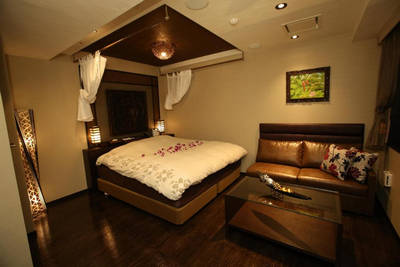 Bali An Resort is a chain of very special themed hotels, inspired by Indonesian resorts, and in particular the island of Bali. The rooms are super spacious, many with whirlpool tubs and TVs in the tub, sofa and massage chair. Free for all guests a selection of dozens of beauty products and bath salts to choose from, including 14 types of shower gel and shampoo, Indonesian snacks and treats, and unlimited alcoholic beverages, one hour in a karaoke room, darts. A truly heavenly resort. Booking.com classifies it as a love hotel, but it's not a classic love hotel, it's a category of its own. Highly recommended for a relaxing night with your partner. There are two hotels of the same chain in Namba: one in Dotonbori and another one in Shinsaibashi.
Price range: double rooms 15,000-18,000¥.
Bali An Resort is a chain of very special themed hotels, inspired by Indonesian resorts, and in particular the island of Bali. The rooms are super spacious, many with whirlpool tubs and TVs in the tub, sofa and massage chair. Free for all guests a selection of dozens of beauty products and bath salts to choose from, including 14 types of shower gel and shampoo, Indonesian snacks and treats, and unlimited alcoholic beverages, one hour in a karaoke room, darts. A truly heavenly resort. Booking.com classifies it as a love hotel, but it's not a classic love hotel, it's a category of its own. Highly recommended for a relaxing night with your partner. There are two hotels of the same chain in Namba: one in Dotonbori and another one in Shinsaibashi.
Price range: double rooms 15,000-18,000¥.
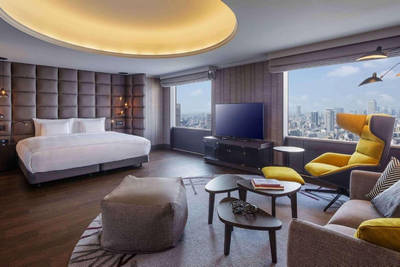 If, on the other hand, you don't want to give up luxury and comfort, without any strange surprises, this five-star hotel in the heart of Namba is the best. It is located inside a skyscraper next to Nankai Namba station, and the mega-shopping complexes Namba City and Namba Parks. Dotonbori's famous Glico Man is 500 meters away. Inside there is a wellness center with gym and indoor swimming pool, as well as six high-level restaurants, one of which is panoramic on the 36th floor. Many rooms on the higher floors of the building also enjoy spectacular city views. The prices are not as high as in other places in Japan or the world for a hotel of this standard. Check it for yourself!
Price range: double rooms 17,000-25,000¥.
If, on the other hand, you don't want to give up luxury and comfort, without any strange surprises, this five-star hotel in the heart of Namba is the best. It is located inside a skyscraper next to Nankai Namba station, and the mega-shopping complexes Namba City and Namba Parks. Dotonbori's famous Glico Man is 500 meters away. Inside there is a wellness center with gym and indoor swimming pool, as well as six high-level restaurants, one of which is panoramic on the 36th floor. Many rooms on the higher floors of the building also enjoy spectacular city views. The prices are not as high as in other places in Japan or the world for a hotel of this standard. Check it for yourself!
Price range: double rooms 17,000-25,000¥.
Eating in Namba, cafes and restaurants
Osaka is famous throughout Japan for its great culinary tradition, and the areas of Namba, and especially of
Dotonbori, are also the most famous in Osaka for eating. Here you will find all kinds of Japanese dishes and more, but obviously
okonomiyaki and
takoyaki are the masters.
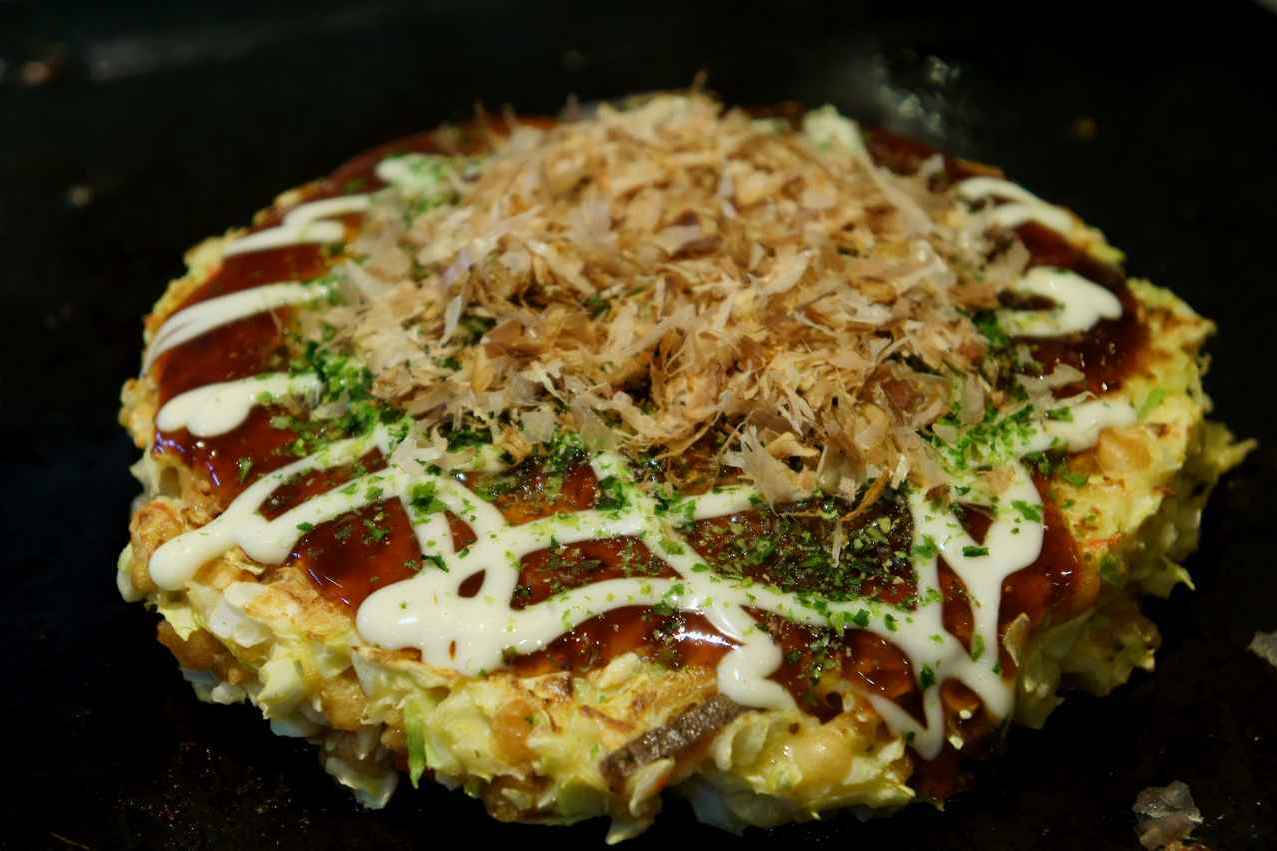
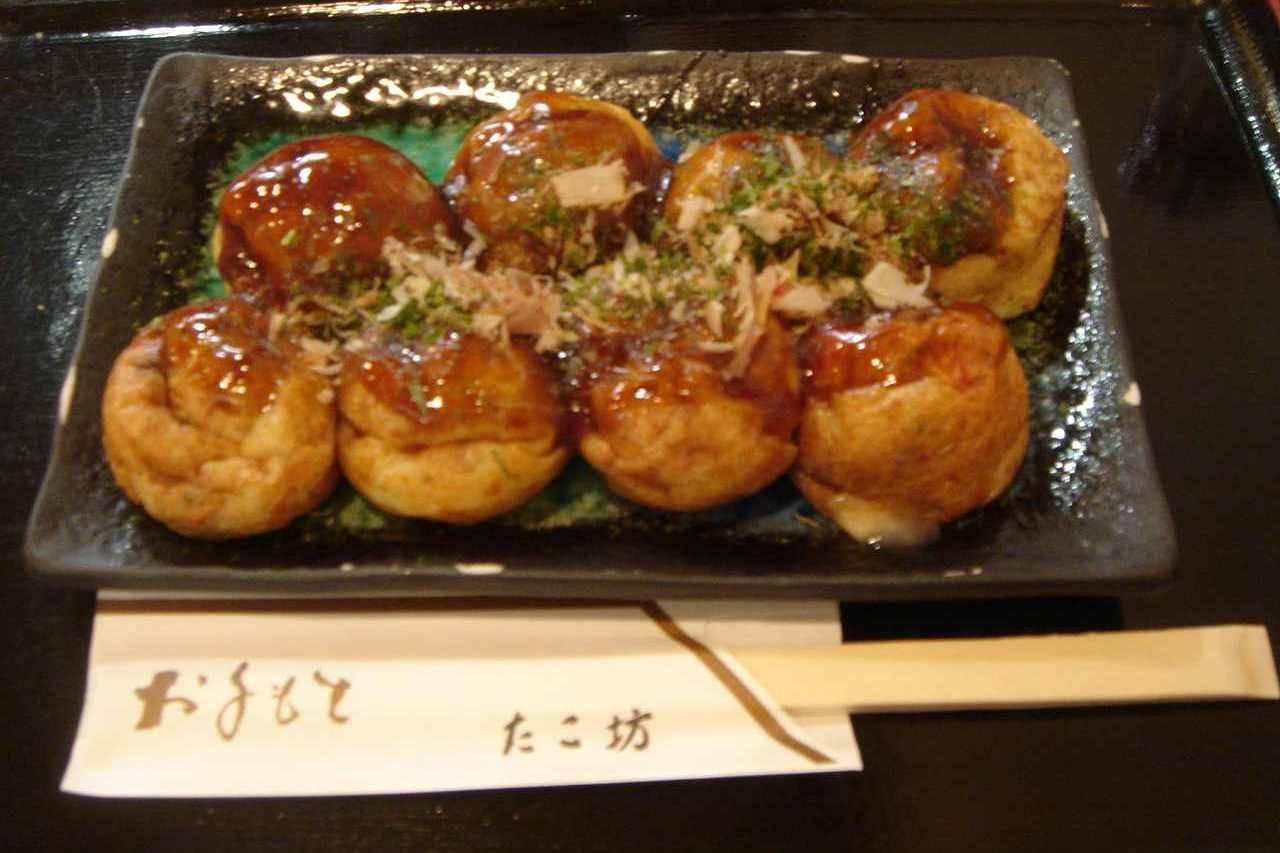 Osaka's most famous dishes, okonomiyaki and takoyaki
Osaka's most famous dishes, okonomiyaki and takoyaki
As we often write on this site, when an area is excessively famous and hosts hundreds of restaurants, instead of going like sheep to those three or four super famous restaurants where almost all tourists flock, sometimes it's more fun to wander around and choose something less beaten. However, if you really want to have a list of recommended places, here it is:
- Takoyaki: one of Dotonbori's most famous takoyaki shops is the Dotonbori Kukuru Konamon Museum, easily recognizable by the giant red octopus on its facade. For a dip in history, you can instead head to one of the stores of Aizuya, which is said to have invented takoyaki in the 1930s. Today Aizuya is a citywide chain and has at least two stores in Namba. Another popular takoyaki kiosk is Otakoya.
- Okonomiyaki: looking for an okonomiyaki restaurant in Namba is like looking for some sand in the desert, they are everywhere. One of the most famous in Dotonbori is Mizuno (but be prepared for a long line), or alternatively Creo-ru (which also makes takoyaki). For a different atmosphere, in the little street Hozenji Yokocho near the temple, we also recommend Houzenji Sampei.
- Ramen: strange as it may seem, Osaka does not have its own particular ramen recipe, the most popular style is that of Hakata. In Namba, Kinryu Ramen is very popular with its particular sign depicting a giant dragon. The chain has 5 restaurants, some of which are open 24 hours. If you want to play it safe, there are also several branches of the legendary Ichiran Ramen chain in the neighborhood. Finally, along the small street Hozenji Yokocho we recommend Hanamaruken.
- Kushikatsu: the kushikatsu district par excellence is Shinsekai, but even in Namba you will be spoiled for choice. In particular, a famous restaurant in Shinsekai, Kushikatsu Daruma, is also present in Namba with more than one restaurant.
- Yakiniku: Opposite the entrance to the small street Hozenji Yokocho we recommend the superb Matsusakagyu Yakiniku.
- Fish: fish and seafood are also very popular in Namba as well as throughout Japan. The Dotonbori area is particularly famous for the crab, also thanks to the famous giant crab sign of the Kani Doraku restaurant which has become a landmark of Dotonbori. In addition to this famous location, Kani Doraku is present with four other stores scattered between Dotonbori and Shinsaibashi. For a more daring experience, we recommend Kaniyoshi, a restaurant that serves crab but also the legendary pufferfish (fugu in Japanese).
How to get to Namba
The neighborhood is centered around the Namba train station and bus station inside the Osaka City Air Terminal (OCAT). The neighborhood is served by numerous railway lines, subways, and buses and is easily reachable from all over the city and also from the airport. However, it can be quite a headache for someone to figure out where to take the correct train. Namba station is not a single station, but rather a collection of many stations, including that of the Nankai company, that of the JR, and that of Kintetsu. In addition, three subway lines (Midosuji, Yotsubashi and Sennichimae) have their own stop called "Namba". When studying an itinerary, always pay attention to the railway company and the respective station in the Namba district. Given the infinity of connections that the neighborhood offers, in this guide we will just give you a few simple tips for the most common cases:
- To/from Shin-Osaka and Osaka Station/Umeda areas, the best alternative is the Midosuji Line of the metro. It takes about 8 minutes and 230¥ to Osaka/Umeda and 15 minutes and 280¥ to Shin-Osaka.
- The Midosuji Line of the metro is also the best alternative for going south to Shinsekai or Tennoji. Dobutsuen-Mae station in front of Shinsekai can be reached in just 4 minutes and 180¥, Tennoji station in front of Abeno Harukas in 7 minutes and 230¥.
- From/to Kansai Airport, Nankai Railways operates direct trains connecting the airport and Nankai Namba station in 35-45 minutes. There are also many buses that connect the airport to Osaka City Air Terminal (OCAT).
- As for excursions outside Osaka, such as Kyoto, Kobe or Himeji, it is best to reach the Umeda area first and from there take one of the available alternatives. The only exception is the connection with Nara, another famous day trip destination from Osaka. With the company Kintetsu you can reach Nara from Namba in about 30 minutes and 1090¥ (limited express service) or 40 minutes and 570¥ (express service). The Kintetsu Nara station among other things is much more convenient than the JR station as it is located near the famous Nara Park and the Kofukuji Temple full of wild fallow deer.
Map of Namba, Osaka
Guided tours, activities and other things to do
If you are planning a trip to Japan and you want to do something more than just visiting famous places and monuments, we suggest you to use
Rakuten Travel Experiences.
How to use Rakuten Travel Experiences
Rakuten Travel is a very useful website to
enrich your travel experience, especially if you are going solo or it's your first time in Japan.
Because of the language barrier (and more), in Japan it is very difficult to interact with the locals and to get off the tourist track.
Thanks to Rakuten Travel you can find a lot of interesting and sometimes unique
guided tours and activities all over Japan (and not only in Japan), that you would otherwise never be able to enjoy.
But there's more: on Rakuten Travel you can also
buy tickets for several famous attractions, events, transportation and other useful services for tourists. Last but not least, you can
reserve a table in hundreds of restaurants.
Some examples
Take a look at Rakuten Travel Experiences
You may also be interested in


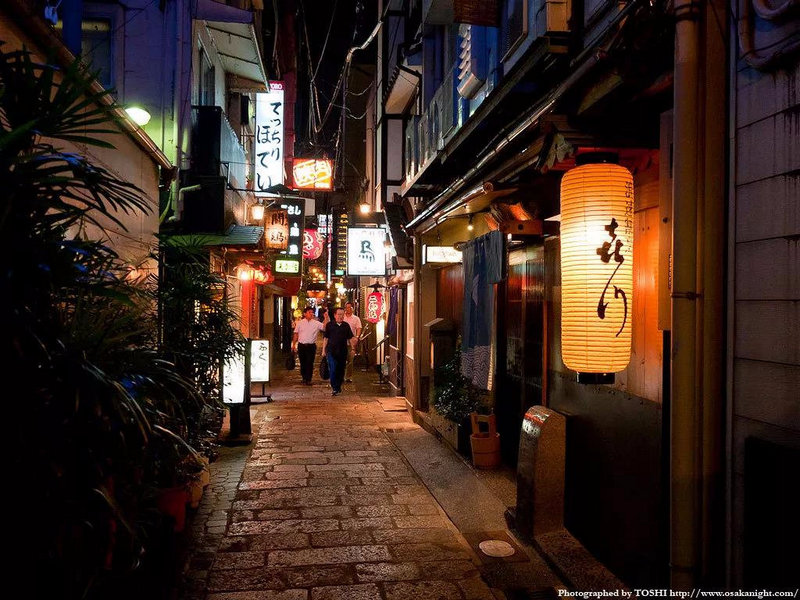 Honzenji Yokocho (credits)
Honzenji Yokocho (credits)







 If capsule hotels scare you for their small size, but you want to try a typical Japanese experience, you can go step by step and start at this cabin hotel in the center of Namba. In a cabin hotel, in addition to the bed, you will have a small corridor with a small table, higher ceilings and a less claustrophobic environment. To better understand what it is, check their website. The property also has large public bathrooms.
Price range: 4,000-5,000¥.
If capsule hotels scare you for their small size, but you want to try a typical Japanese experience, you can go step by step and start at this cabin hotel in the center of Namba. In a cabin hotel, in addition to the bed, you will have a small corridor with a small table, higher ceilings and a less claustrophobic environment. To better understand what it is, check their website. The property also has large public bathrooms.
Price range: 4,000-5,000¥.
 Bali An Resort is a chain of very special themed hotels, inspired by Indonesian resorts, and in particular the island of Bali. The rooms are super spacious, many with whirlpool tubs and TVs in the tub, sofa and massage chair. Free for all guests a selection of dozens of beauty products and bath salts to choose from, including 14 types of shower gel and shampoo, Indonesian snacks and treats, and unlimited alcoholic beverages, one hour in a karaoke room, darts. A truly heavenly resort. Booking.com classifies it as a love hotel, but it's not a classic love hotel, it's a category of its own. Highly recommended for a relaxing night with your partner. There are two hotels of the same chain in Namba: one in Dotonbori and another one in Shinsaibashi.
Price range: double rooms 15,000-18,000¥.
Bali An Resort is a chain of very special themed hotels, inspired by Indonesian resorts, and in particular the island of Bali. The rooms are super spacious, many with whirlpool tubs and TVs in the tub, sofa and massage chair. Free for all guests a selection of dozens of beauty products and bath salts to choose from, including 14 types of shower gel and shampoo, Indonesian snacks and treats, and unlimited alcoholic beverages, one hour in a karaoke room, darts. A truly heavenly resort. Booking.com classifies it as a love hotel, but it's not a classic love hotel, it's a category of its own. Highly recommended for a relaxing night with your partner. There are two hotels of the same chain in Namba: one in Dotonbori and another one in Shinsaibashi.
Price range: double rooms 15,000-18,000¥.
 If, on the other hand, you don't want to give up luxury and comfort, without any strange surprises, this five-star hotel in the heart of Namba is the best. It is located inside a skyscraper next to Nankai Namba station, and the mega-shopping complexes Namba City and Namba Parks. Dotonbori's famous Glico Man is 500 meters away. Inside there is a wellness center with gym and indoor swimming pool, as well as six high-level restaurants, one of which is panoramic on the 36th floor. Many rooms on the higher floors of the building also enjoy spectacular city views. The prices are not as high as in other places in Japan or the world for a hotel of this standard. Check it for yourself!
Price range: double rooms 17,000-25,000¥.
If, on the other hand, you don't want to give up luxury and comfort, without any strange surprises, this five-star hotel in the heart of Namba is the best. It is located inside a skyscraper next to Nankai Namba station, and the mega-shopping complexes Namba City and Namba Parks. Dotonbori's famous Glico Man is 500 meters away. Inside there is a wellness center with gym and indoor swimming pool, as well as six high-level restaurants, one of which is panoramic on the 36th floor. Many rooms on the higher floors of the building also enjoy spectacular city views. The prices are not as high as in other places in Japan or the world for a hotel of this standard. Check it for yourself!
Price range: double rooms 17,000-25,000¥.